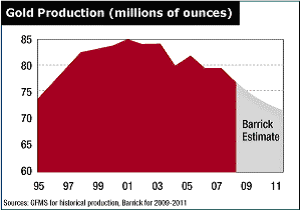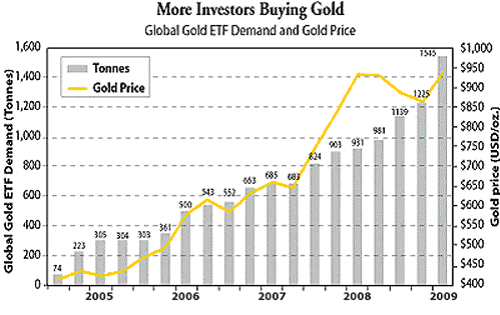We’ve all heard that inflation drives up gold prices. When inflation is on the rise, investors buy more gold to hedge their portfolios.
And, with all the government bailouts and stimulus packages, it’s hard to deny that inflation is coming. After all, the money supply has more than doubled since October.
Yet few people realize that inflation may be the least of the reasons why gold prices will push higher.
Since bottoming out in 2001, gold prices have risen by nearly 300% and is now trading above the $1,100. And that’s happened in a relatively “inflation-free zone.”
There are other forces at work here. This report will show you exactly why inflation is only a small part of the gold story. And, we’ll identify the best ways to profit from the coming gold rush.
Gold Trend #1: Gold Mine Production is Decreasing.
Annual worldwide mine production of gold has decreased by 9.3% since 2001. Considering gold prices have nearly quadrupled since then, why isn’t more gold being produced? The answer is simple. Resources are being depleted and their quality is diminishing. And, when a discovery is made, it takes about 7-10 years to get a mine permitted and into production – making it difficult to quickly ramp up gold production.

BUY GOLD PRODUCTS
Gold Trend #2: Gold is Getting Harder to Find.
Fewer and fewer large gold discoveries are being made every year. And the discoveries that are being made tend to be in more remote and less geopolitically attractive areas. Considering that the risks to opening any gold mine are considerable, mining companies just aren’t interested in mining in areas that have significant political and geographical drawbacks. As a result, miners are having difficulty replacing depleted resources.
Gold Trend #3: Investment Demand for Gold.
Large institutional investors, such as hedge and pension funds, are making large allocations to gold and gold shares. Individual investors are also getting in on the action, with gold exchange-traded funds (ETFs) gaining influence. SPDR Gold Trust (NYSE: GLD), the largest physically backed ETF on the planet, is now the 6th biggest holder of gold bullion with more than 1000 tons. That is helping to facilitate and spread the ownership of gold by individuals. In fact, in the first half of 2009 investment demand for gold is up 150% over the first half of 2008, according to the World Gold Council.

WHAT ARE YOU WAITING FOR? BUY SOME GOLD FOR YOURSELF NOW!
Gold Trend #4: Central Banks are Buying Gold.
The Central Bank Gold Agreement, originally signed in 2001 and recently renewed for another five years, limits the amount of gold European central banks – including the International Monetary Fund – can sell to 400 tons per year. This means that even if governments want to sell off their gold reserves, they can’t – further straining the supply of gold on the market. The U.S., the world’s largest holder of gold, is holding on to their stash as well. Some governments are going even further: Venezuela’s Finance Ministry now requires 70% of gold produced in the country to be sold domestically. At the same time, Russia, Ecuador, Mexico and the Philippines are all buying gold. And China has increased its reserves by a staggering 76%.
Gold Trend #5: Push for Gold-backed Currencies.
As investors the world over lose faith in their government’s ability to contain the financial and economic crises, many are calling for gold backed currencies – much like the U.S. dollar was until the early 1970’s. Even Zimbabwe, which a year ago had hyperinflation running at 231 million percent annually, is now considering reintroducing its Zimbabwe dollar, but this time fully backed by assets, including gold. In order for this to happen, countries would have to purchase enough gold to back all their currency – putting extreme pressure on the gold supply.
BUY GOLD PRODUCTS
Gold Trend #6: Asian Demand for Gold is Exploding.
Asia, with its more than two and a half billion people, has a major impact on investment demand. Asians have a long-standing cultural affinity for gold as a store of wealth. India is the world’s largest gold consumer. For the last 50 years, until 2009, the Chinese government has forbidden its citizens from owning gold. But now China is encouraging its citizens to buy silver – which automatically draws more attention to gold. Today, Chinese investors even have access to gold-linked checking accounts. As a result, demand for gold in mainland China is expected to triple in the next few years.
Gold Trend #7: Gold is in a Secular Bull Market.

Gold’s price has increased every single year since 2001. This is a clear signal that we are currently in the middle of a secular bull market for gold. A secular bull market typically last about 17 years and ends with a mania stage where investors throw the concept of supply and demand out the window and frantically invest in gold. We’ve seen this same pattern repeat itself over the last hundred years of investment history and we’re about to see a major run up in gold prices. The gold market is very small in relation to the currency, bond or stock markets, so when investors start to pile in, look out. Prices will go through the roof – making the tech and housing bubbles seem small in comparison.
YOU CAN BUY GOLD PRODUCTS HERE







No comments:
Post a Comment